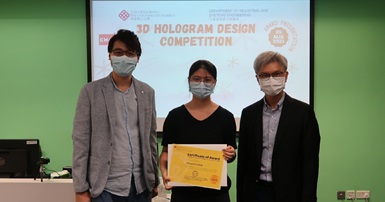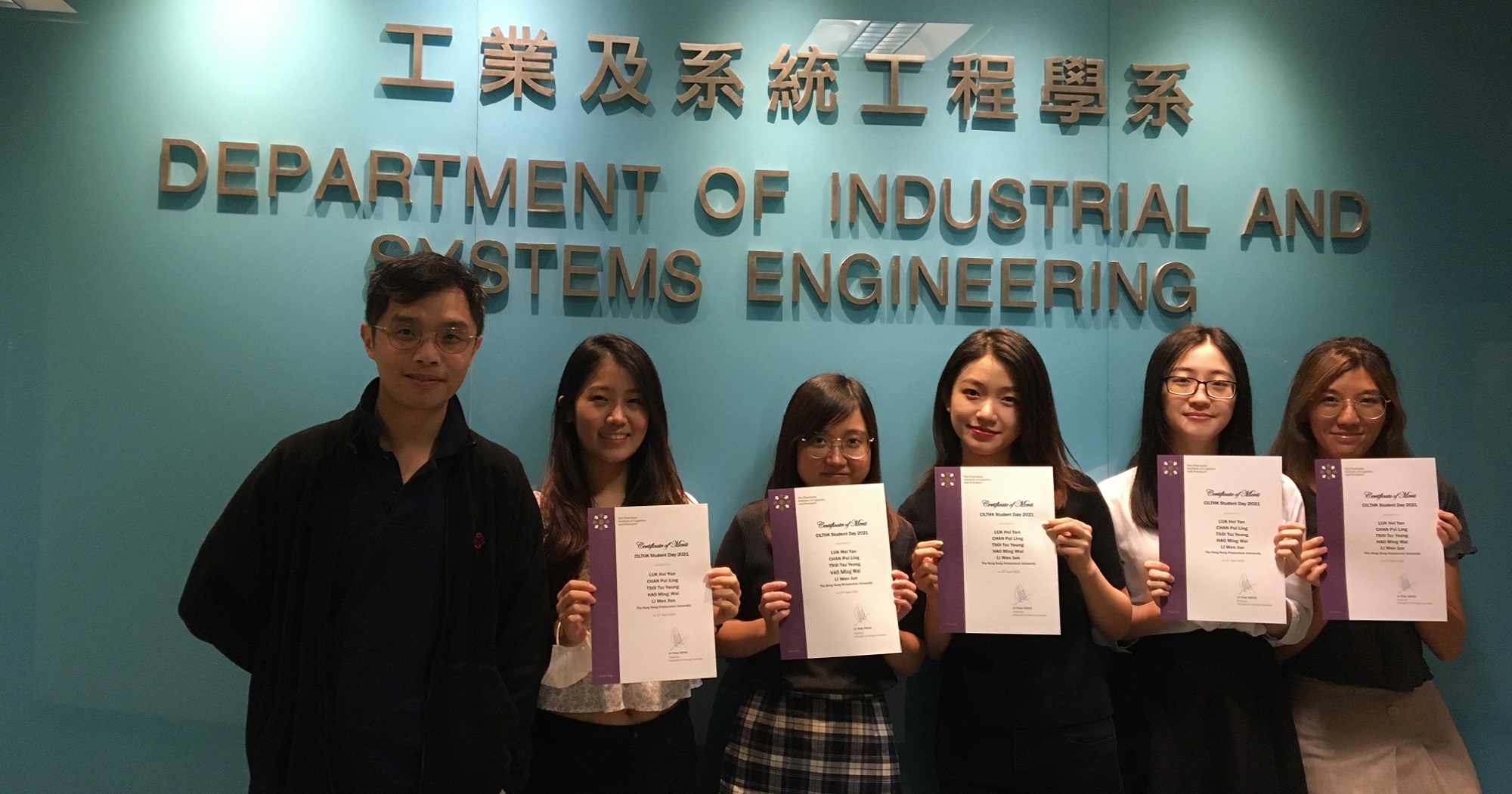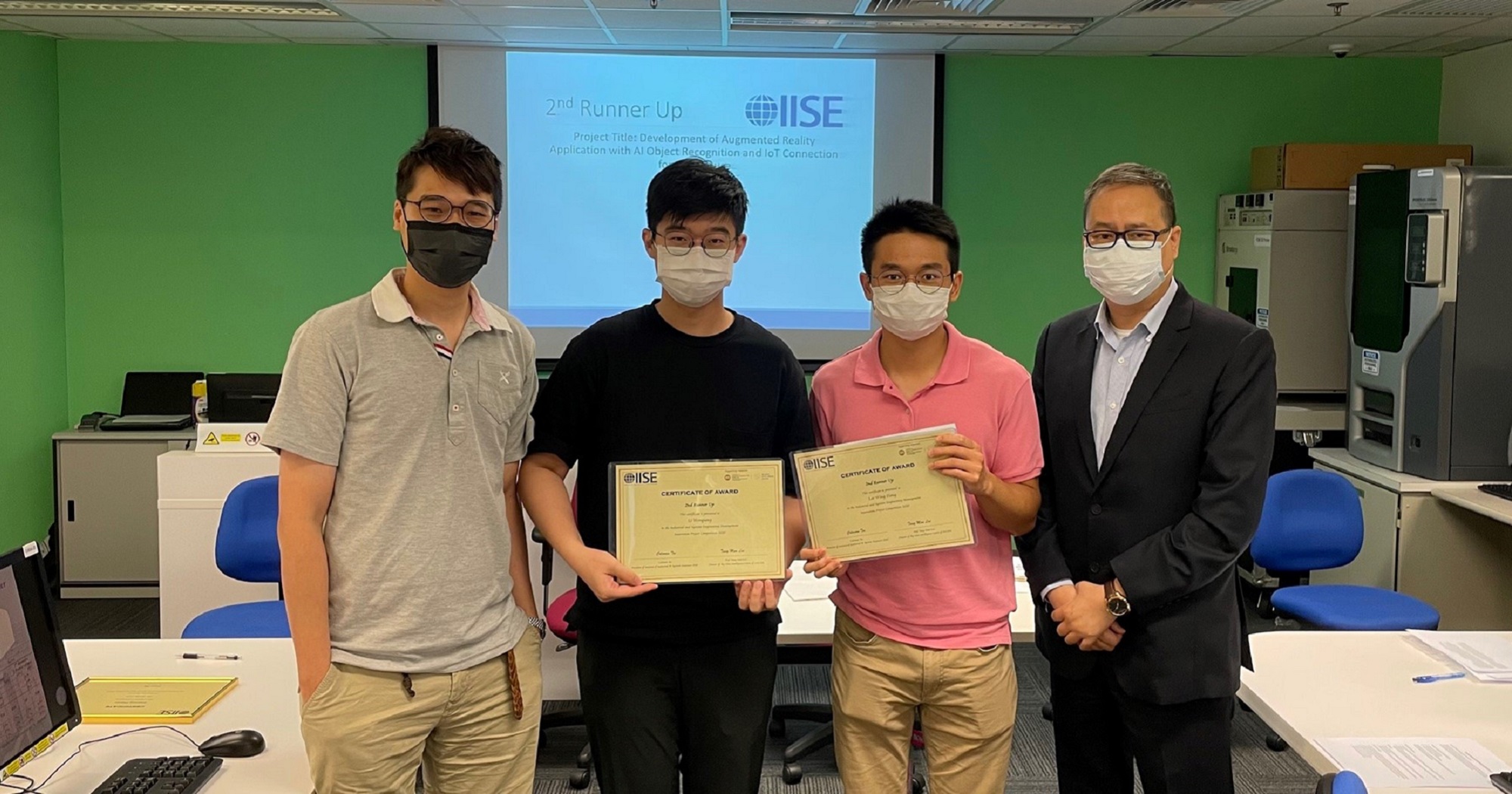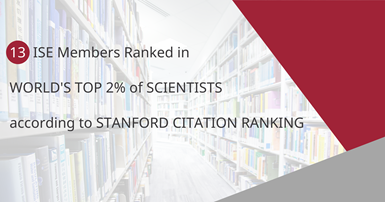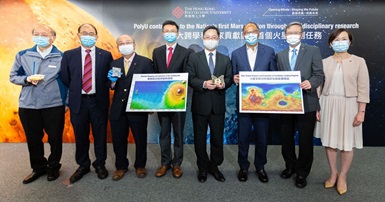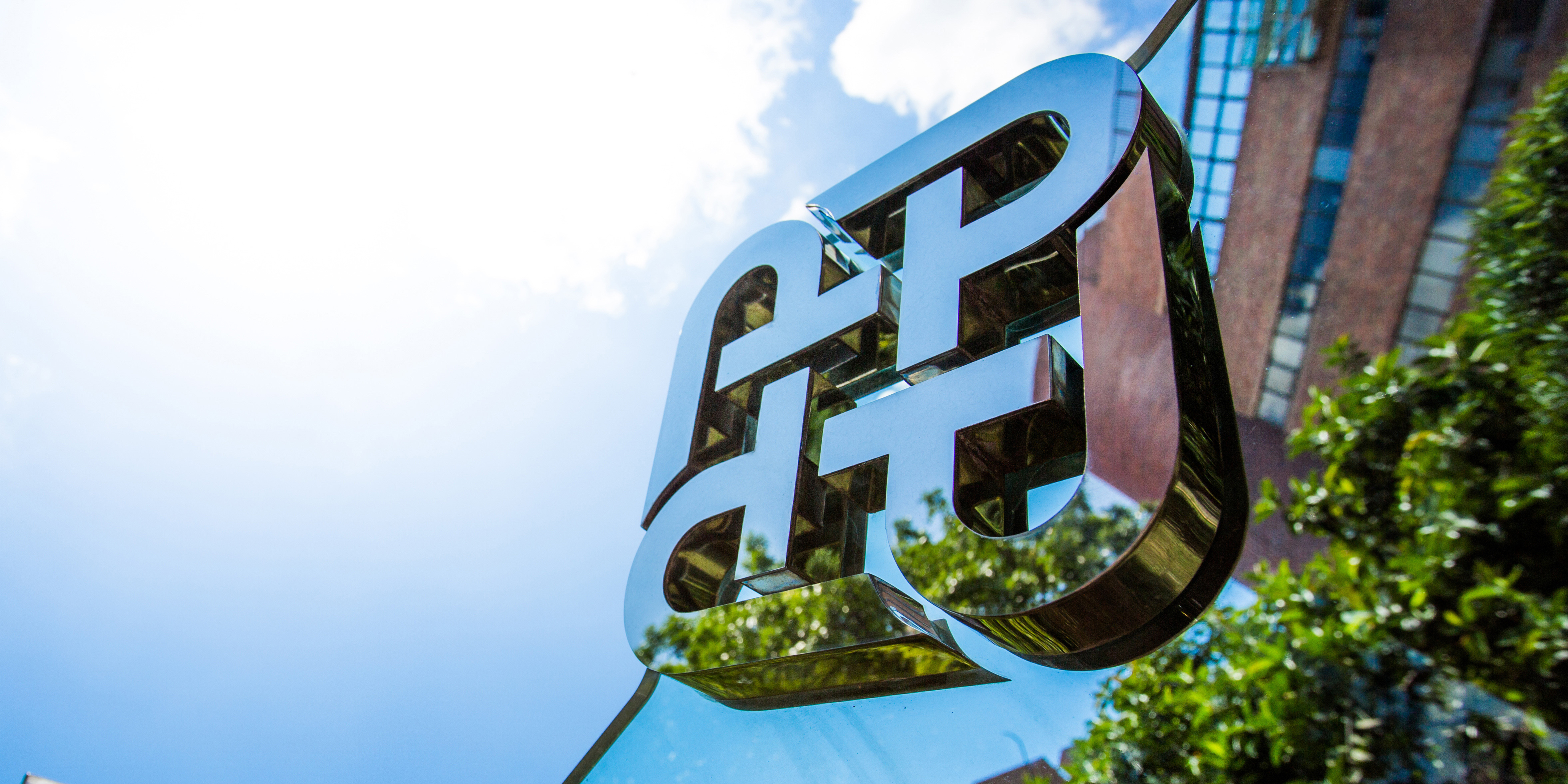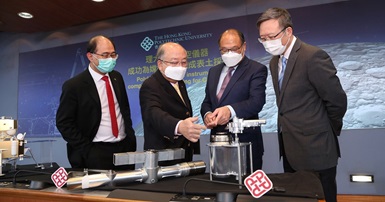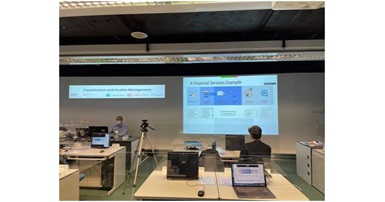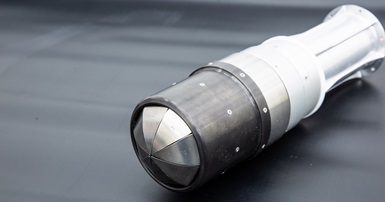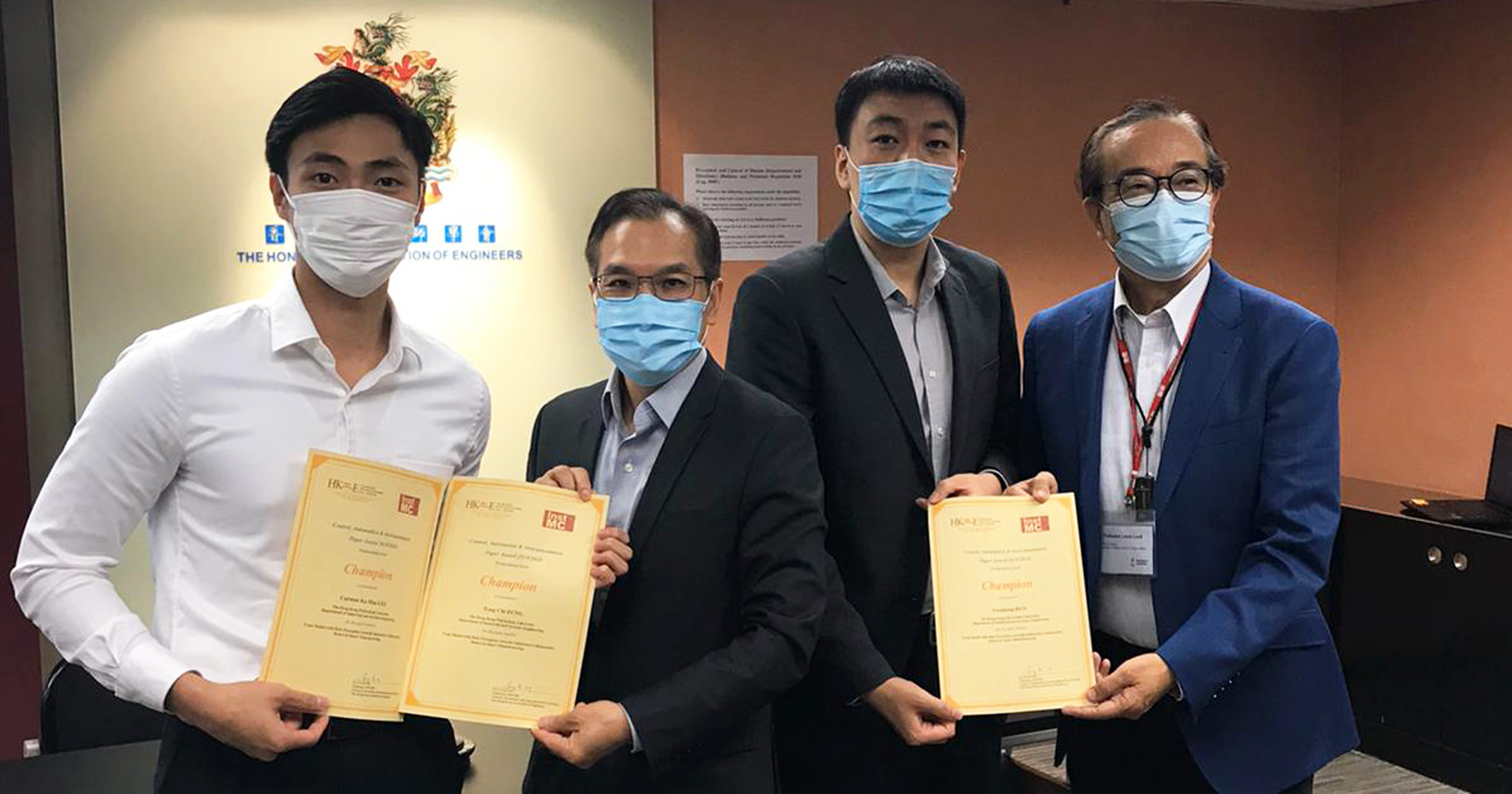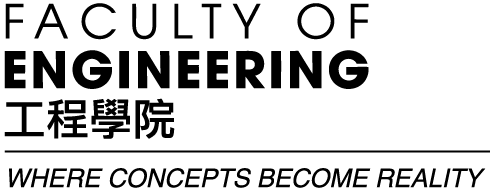PolyU contributes to the Nation’s first Mars mission with multidisciplinary research 理大跨學科專家貢獻國家首個火星探測任務
Two research teams at The Hong Kong Polytechnic University (PolyU) contributed to the Nation’s first Mars exploration project Tianwen-1. By harnessing their extensive experience in the field of aerospace science and technology, as well as their commitment to research excellence, PolyU researchers played a vital role in the Tianwen-1 mission, in collaboration with the China Academy of Space Technology (CAST). Professor WU Bo helped identify possible landing regions with advanced topographic mapping and geomorphological analysis technologies. Professor YUNG Kai-leung developed a sophisticated space instrument, the “Mars Landing Surveillance Camera (Mars Camera)”, for capturing images of the surroundings of the Red Planet and monitoring the status of the Zhurong Mars rover.
The spacecraft for the Tianwen-1 probe comprises an orbiter, a lander and the Zhurong rover, aiming to complete orbiting, landing and roving in one single mission, which is the first such attempt in global aerospace history. The mission aims to obtain scientific exploration data on the Red Planet, and currently, Tianwen-1 has completed orbiting Mars and has successfully landed on a pre-selected landing region on the Utopia Planitia of Mars. The Mars rover Zhurong is also due to begin Martian exploration.
Dr LAM Tai-fai, Chairman of Council, PolyU, offered his warmest congratulations to the Nation on the successful soft landing of Tianwen-1. He said, “The Nation has developed an impressive track record in deep space exploration, such as its lunar exploration and lunar sample return missions. This time the Nation begins its planetary exploration journey by setting its sights on Mars for the first time, which further cements China’s advanced space capabilities. We are immensely encouraged that PolyU played a pivotal part in facilitating the Tianwen-1 mission. With extraordinary creativity, perseverance and innovative minds, our researchers will continue to contribute to the well-being of mankind in various scientific fields.”
Mr Alfred SIT, Secretary for Innovation and Technology of the HKSAR Government, said, “I would like to extend my heartfelt congratulations to our Nation on the successful landing of the Nation’s first Mars exploration project. Basic research is the strength of local universities, and the fact that PolyU was invited to participate in another major national space mission with its scientific research capabilities is a clear demonstration of Hong Kong’s exceptional strength in research and innovation. Hong Kong is also a place where many hidden talents emerge, forming an important force in national technological advancement. They will contribute to the Nation’s ‘Megascience’ projects with their expertise. I hope that local universities take advantage of research collaboration opportunities with institutions in the Mainland to create synergies that bring about complementary advantages.”
Professor Jin-Guang TENG, PolyU’s President, said, “We sincerely thank our Nation for trusting PolyU and inviting two of our Professors to participate in this national Mars exploration project. We are proud to have the opportunity to once again contribute to a major national aerospace technology mission. Leveraging the achievements of PolyU in the field of aerospace technology, we have decided to increase our support in this area by establishing the University Research Centre for Deep Space Explorations led by Professor Yung Kai-leung. We aim to pool together experts in different fields such as Geology, Architecture, Machinery, Physics, and Remote Sensing to conduct in-depth research in different aspects of aerospace technology. We truly hope that the mission of Tianwen-1 will be a great success and that the world will learn more about the Red Planet.”
Mars landing site mapping and evaluation
Landing on Mars is a challenging endeavour due to several reasons, such as the complicated Martian surface, the very thin atmosphere as well as possible dust storms. There is also a 5-20 minutes time delay between Mars and Earth communications. It is therefore of paramount importance to select a landing site that is safe and of scientific significance.
From 2017-2020, upon invitation by CAST, Professor WU Bo from PolyU’s Department of Land Surveying and Geo-Informatics led a team to carry out global-scale analysis and evaluation to help shortlist three candidate landing regions, namely the Amazonis Planitia, Chryse Planitia, and Utopia Planitia, that are all located within a latitude ranging from 5° - 30°N on Mars. These regions have adequate solar illumination for optimised power generation and moderate temperature, lower elevation for longer deceleration time, and a flat terrain surface for safe landing.
The team further conducted detailed topographic and geomorphological mapping and analysis of the candidate landing regions, including their elevations, slopes, rock abundances, crater densities, and geological contexts. As a result of the evaluation, a region in the southern Utopia Planitia, the largest recognised impact basin in the northern hemisphere of Mars, was selected as the target landing region. Some features in the Utopia Basin like extensive sedimentary materials on the surface have been interpreted as morphological indicators of potential water-ice underneath, which are of great scientific interest since they may offer new insights into the existence of life on Mars and the evolutionary history of the Red Planet.
Since entering the orbit of Mars on 10 February 2021, the Tianwen-1 probe has collected and sent back a large quantity of sub-meter-resolution images of the target landing region covering an area of about 70km × 180km, which is about 11 times larger than the size of Hong Kong’s territory. Using the high-resolution images from Tianwen-1, Professor Wu and his team generated high-resolution and high-precision 3D digital topographic models of the target landing region using the self-developed integrated 3D mapping model, to analyse the detailed topography and identify large slopes hazardous for landing.
To facilitate safe landing and roving on Mars, Professor Wu’s team also developed AI-based techniques for more automated and robust analysis of geomorphological features like craters and rocks from the high-resolution images in a short period of time. Professor Wu said, “With the aid of the AI-based techniques, we analysed over 670,000 craters, over two million rocks, and hundreds of volcanic cones distributed over the target landing region in 1.5 months. We achieved much higher efficiency in the automatic extraction of rocks and craters with about 85% correctness.” From the topographic and geomorphological mapping results, the team successfully identified several landing ellipses for the mission management team to finalise the landing site.
Professor Wu felt very honoured to be able to participate in and contribute to the Nation’s Mars exploration project. He said, “The Tianwen-1 mission is a mega project, and we are only a small part of an effort of thousands of people, to support the accomplishments of the mission. All of my team members were fully dedicated to the undertaking over the past months. I am thankful to them for working around the clock to get the task completed on time, yet without comprising accuracy and details.”
Mars Landing Surveillance Camera (Mars Camera)
With a wealth of experience in developing sophisticated space instruments, Professor Yung Kai-leung, PolyU’s Sir Sze-yuen Chung Professor in Precision Engineering, Chair Professor of Precision Engineering and Associate Head of Department of Industrial and Systems Engineering, has led a team to undertake the research, design and manufacturing of the Mars Camera since 2017. Thanks to their dedication and perseverance, as well as the support of the University, the team successfully completed and delivered the Mars Camera with the corresponding space qualification experiments in less than three years.
The PolyU-developed Mars Camera is located on the outside top surface of the lander platform, for monitoring the landing status, the surrounding environment of Mars and the movements of the Zhurong rover with respect to the unfolding and status of the solar panels and antennae. This information is critical for the successful movement of the Mars rover on the surface of Mars.
The Mars Camera is light in weight (around 390g), yet strong and durable enough to withstand the extreme temperature differences of about 150 degrees Celsius experienced during the nine-month journey between Earth and Mars, followed by immediate operation under the extremely low temperatures on the surface of Mars. As the Mars Camera is designed for the lander, it also has to withstand huge impact shocks of 6,200G (i.e. 6,200 times the force of Earth’s gravity). Despite having a wide-angle field of view (a maximum of 120 degrees horizontally and a maximum of 170 degrees diagonal), the Mars Camera has low image distortion.
Professor Yung explained, “To capture ultra-wide angle images on Mars for scientific research, the Mars Camera has to have a wide field of vision with low distortion optics within the little allowable payload, but at the same time must also be able to withstand extreme temperature variation, high radiation, mechanical impact and vibration within the little available mass, whereas maintaining high reliability under the extreme space travel environment such as high radiation.”
Professor Yung further shared that he was relieved that the PolyU-developed Mars Camera survived the Earth to Mars journey, “It was a real thrill when we learned that Tianwen-1 successfully touched down onto the Martian surface. A photo recently released by the China National Space Administration shows our Mars Camera on the Red Planet, and I am particularly excited to observe from the photo that our Camera remains intact. I look forward to seeing our Mars Camera capturing the spectacular views of Mars and providing images of the unfolding and movement of the Zhurong rover.”
香港理工大學(理大)兩支跨學科研究團隊為國家近日首個火星探測項目「天問一號」作出貢獻。理大的科研人員憑藉多年來在航太科研領域所累積的豐富經驗,及卓越的研發成果,與中國空間技術研究院合作,在「天問一號」任務中發揮重要作用。當中吳波教授團隊研發創新的地形測量及地貌分析方法,協助選取火星著陸點。容啟亮教授的團隊則研發出精密的太空儀器「落火狀態監視相機」(「火星相機」),拍攝火星的周遭環境及火星車的狀況。
「天問一號」探測器由環繞器、著陸器和巡視器 (又名「祝融」火星車) 組成,目標是一次過完成「繞、落、巡」(即「環繞」、「著陸」和「巡視」)三大工作,是世界航天史上的首次嘗試;這次任務旨在獲取有關火星的科學勘探數據。目前,「天問一號」已完成火星軌道環繞及著陸預選著陸區烏托邦平原,「祝融」火星車正侍機展開巡視及勘探工作。
理大校董會主席林大輝博士祝賀「天問一號」成功著陸火星,他表示︰「國家在深空探測的成績令人振奮,過去在月球探索及採月壤帶回地球的任務,均取得圓滿成功;今次國家的航天任務更跨越星際,首次探索火星,進一步印證中國的航天實力。理大的科研人員有份參與火星任務,並發揮關鍵作用,令我們十分鼓舞。理大科學家將繼續以非凡的創造力、毅力和創新思維,在不同領域上參與科研,冀為人類的福祉貢獻己力。」
香港特別行政區創新及科技局局長薛永恒先生表示: 「我衷心恭賀國家首次火星探測任務成功著陸。基礎研究是本地大學的強項,今次理大以其科創實力,再次獲邀參與國家重要航天任務,充分顯示香港科研實力雄厚,臥虎藏龍,是國家科技建設的一支重要力量,可為國家級的『大科學』項目作出貢獻。我深信本地大學亦可藉著與內地機構的科研協作,發揮協同效應,優勢互補。」
理大校長滕錦光教授說︰「我們衷心感謝國家對理大的信任,邀請兩位教授參與國家的火星探測任務。理大有機會再次為國家的重大航天科技項目做貢獻,我們深感自豪。基於理大在航天科技領域已經取得的成績,我們決定加大對該領域的支持力度。最近,理大已成立由容啟亮教授領導的『深空探測研究中心』,聚集地質學、土木工程、機械過程、物理學等不同領域的專家,在航天科技的不同方向展開深入研究。我們衷心祝願『天問一號』任務取得圓滿成功,讓世界對這個『紅色星球』有更加多的瞭解。」
火星著陸區測量和評估
登陸火星是一項極具挑戰性的任務。火星表面的地形複雜,大氣層稀薄,而火星表面隨時可能出現的沙塵暴,加上火星與地球通訊有約5至20分鐘的延遲,凡此種種增加了登陸火星的難度。因此,選擇一個安全而具有科學價值的著陸點至關重要。
2017至2020年期間,理大土地測量及地理資訊學系吳波教授應中國空間技術研究院的邀請,率領團隊進行火星全球的分析和評估,篩選出三個候選著陸區,分別位於亞馬遜平原、克里斯平原和烏托邦平原。這些候選著陸區均處於火星緯度5°- 30°N範圍,太陽日照充足,有助太陽能電池板供電,温度適中;且位處低海拔,可以延長探測器降落時減速的時間;地形平坦,有利探測器安全著陸。
理大團隊進一步對候選著陸區進行了詳細的地形及地貌特徵分析,包括其海拔、坡度、岩石密度、撞擊坑密度,以及該區域的地質歷史。綜合研究結果,火星北半球最大的撞擊盆地烏托邦平原南部區域獲選為「天問一號」的目標著陸區。烏托邦平原的某些特徵,如其表面上廣泛存在的沉積物,顯示這個區域地下可能存在水冰,因此其科學意義重大,有助找出火星是否曾有生命的線索,了解火星的演化歷史。
「天問一號」自2021年2月10日進入環火軌道後,已收集並傳回大量覆蓋目標著陸區的亞米級高解像度圖像回地球。是次任務的目標著陸區面積達70公里 x 180公里,即比整個香港的面積大11倍。吳波教授及其團隊利用自行研發的「三維集成測量模型」,將「天問一號」傳回的高解像度圖像,製成高精確度、高解像度的三維數碼地形模型,以詳細分析地形特徵,識別可能影響著陸安全的大型斜坡。
為了幫助「天問一號」在火星上安全著陸和巡視,吳波教授及其團隊亦研發出「基於人工智能的撞擊坑、石塊提取方法」,在短時間內從高解像度的圖像上自動提取撞擊坑和石塊等地貌特徵,以作更精確的分析。吳教授說:「我們利用這項人工智能技術,在一個半月內分析了分佈在目標著陸區內的67萬個隕石坑、逾200多萬塊岩石,和數百個火山錐,效率超卓,準確率達到了85%。」團隊根據地形和地貌的詳細測量結果,成功搜索出數個可能的著陸點,供「天問一號」任務的管理團隊作最終抉擇。
吳教授十分榮幸能夠參與國家的火星探測任務,並貢獻力量。他說:「『天問一號』火星探測任務是一個龐大的工程,是成千上萬人的努力成果,我們只是當中的一顆『螺絲釘』。過去幾個月,我的每一位團隊成員為這個項目全力以赴,日以繼夜工作,精益求精,沒有因為時間緊迫而對準確度和工作中的細節讓步,最終我們在限時內完成任務。」
「落火狀態監視相機」(「火星相機」)
理大工業及系統工程學系鍾士元爵士精密工程教授、精密工程講座教授及副系主任容啓亮教授研發精密太空儀器的經驗豐富。容教授自2017年起率領團隊,就「火星相機」進行研究、設計及製造。有賴整個團隊努力不懈,以及大學的支持,理大團隊在不到三年內,成功研製並交付火星相機,並通過多項相關的太空驗證。
理大的「火星相機」搭載於著陸器外層平台上,以監視著陸情況、火星的周遭環境,以及降落火星後巡視器「祝融」的操作狀態,包括太陽翼的打開及天線的狀況。這些資訊對掌握巡視器能否在火星表面成功巡視至關重要。
「火星相機」重量輕巧(約390克),然而外殼十分堅固,以抵受穿梭地球與火星超過九個月的旅程期間出現約攝氏150度的極端溫差,及後須能在火星表面極低溫的環境下運作,並要承受相等於地球地心吸力6,200倍的衝擊。此外,「火星相機」須具備廣闊測量視野(水平視野範圍達到120度,對角線視野範圍達到170度),同時顯著減低圖像變形的程度。
容教授解釋︰「為了拍攝超廣闊的圖像及影片作科學研究之用,火星相機須輕巧並具備廣角拍攝及可控的影像變形,同時要在有限的重量內能抵受極大的衝擊力。此外,相機須在長時間的太空旅程中克服極端溫差、輻射、機械振動等挑戰,最後仍保持十分高的穩定性。」
容教授對於理大研發的「火星相機」能在地球前往火星的長途旅程中保持完好,感到如釋重負。「得悉天問一號成功著陸火星,我和我的團隊非常興奮。從國家航天局日前公布的圖片中,我很高興看到我們的『火星相機』狀態良好。期待理大的火星相機拍攝到火星的壯麗景色以及火星車打開及運行的情況。」
[From PolyU Media Release]

